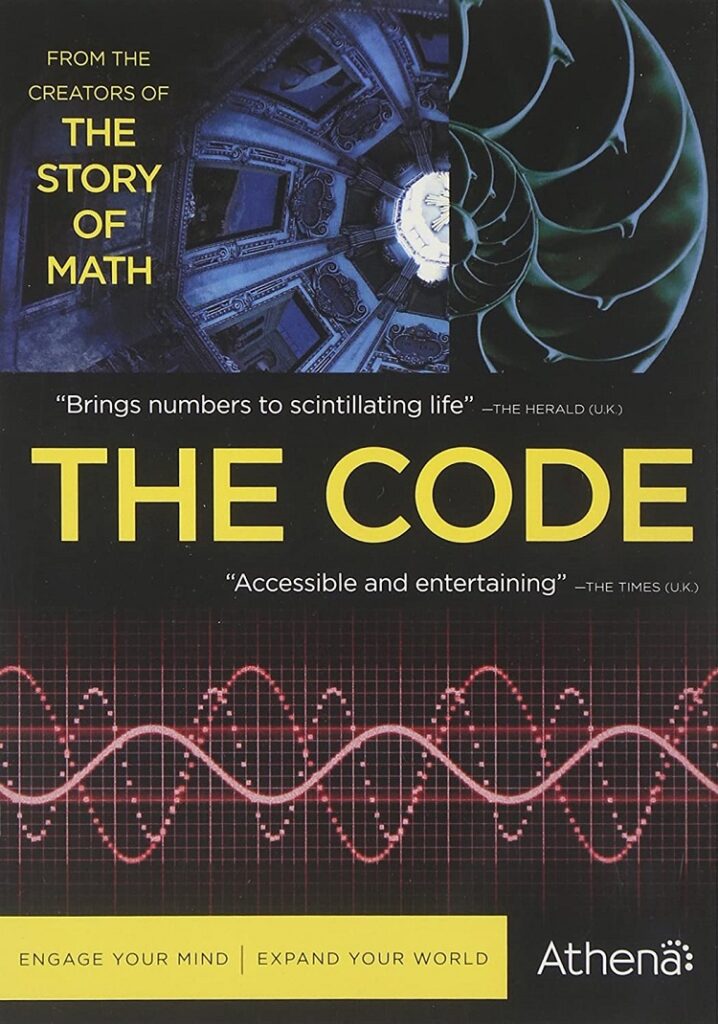
The new Athena two-DVD set The Code is not to be confused in any way with The Da Vinci Code. This highly-acclaimed, three-episode British series is far more interesting than that bit of fiction ever could be. In The Code, Oxford professor Marcus du Sautoy explores mathematical “codes” that appear in nature with such frequency that it is hard to believe they are truly random.
In the first episode, “Numbers,” du Sautoy compares such seemingly disconnected phenomena as the French Chartres Cathedral, the cicada, Stonehenge, and the way we hear sound. In all, the design comes down to nearly identical mathematical formulas. It is an amazing experience to see how these (and many other) forms follow the same basic rules. The professor’s thesis that there is an underlying code to the universe is introduced very effectively in this first chapter of the series.
The second program is titled “Shapes,” and was as compelling, if not more so, than “Numbers.” During “Shapes,” the professor begins at the amazing Giant’s Causeway in Northern Ireland. For those who are unfamiliar with this natural rock formation, it is a collection of some 40,000 stones, all in an incredibly precise hexagonal formation. We then see him in a beekeeper’s outfit, where he is showing us the exact same formations in bee-hives. As we are shown in a number of other examples, the hexagon is the most “perfect” formation for joining various units together.
The idea of the hexagon, the square, and the triangle are all explored as options for forming a whole out of smaller pieces. It is with the triangle where the episode ends however. In another “truth is stranger than fiction” story, we are shown exactly how the film studio Pixar was begun. Most people associate it with Steve Jobs, who definitely had a major hand in taking it from an upstart to what it is today, but it did not begin with him by any means.
The studio’s beginnings came in the early eighties when a Boeing employee had a “eureka” moment while attempting to illustrate an airplane flying over a computer-generated mountain range. He began with a formation of triangles, then slowly multiplied and shrunk them inside themselves. What emerged were seemingly random mountains. When he realized what he had discovered, and the potential for it in animation, he formed Pixar. One of the earliest examples of this technology can be seen in Star Trek: The Wrath of Khan (1982), during the scene where Kirk, Spock, and Dr. McCoy are viewing the proposal for the “Genesis Project.” To quote Spock from that very scene, “Fascinating.”
The third and final installment is “Prediction.” As the title indicates, this episode focuses on predicting behavior based on well-known patterns. One of the most inexplicable examples is that of a flock of birds, which we have all seen. How is it that hundreds of individual swallows are able to instantly change direction as a whole? As Professor du Sautoy explains, each bird needs only to keep track of a total of seven others, and often only the three closest to it, no matter what direction they move in. The wild swings they make are usually in response to perceived threats.
Taking the bird analogy into Grand Central Station, we see how humans behave in very much the same way. The problem with predicting the future however is the “other” universal code, that of chaos. As he so eloquently illustrates for us, the introduction of just one minor, random element can throw every calculation completely off track.
In conclusion, while there are “codes” that seem to rule much of the universe, they exist hand-in-hand with “chaos,” which makes it all seem random. But even “random” is not truly random as it turns out. In a final, brilliantly simple example, du Sautoy takes a large jar of jellybeans around to 160 people, asking them to guess the number inside. The numbers range from a low of 400, to a high of 50,000. Four people come close to the actual number of 1415. When all of the guesses are averaged out however, the result is incredible. Something like 1416 is the mean number. It shows that even random, “chaotic” highs and lows eventually cancel each other out.
The set includes three short bonus features, each running about four minutes. They are Phi’s the Limit, Go Forth and Multiply, and Imagining the Impossible: The Mathematical Art of M.C. Escher. Of these, I found the Escher piece the most interesting, although all three are certainly worth viewing. There is also an eight-page booklet which discusses the early history of mathematics, Pi, and some of the famous sites visited in the program.
The Code is one of the most intriguing educational programs I have seen in some time. I doubt if I will ever look at a simple seashell the same way ever again.